 |
The following advice constitutes the notes for the lecture on Feature Writing delivered on 12th May 2003.
The art of feature writing is to be creative and flexible within a distinct structure.
This structure looks something like this...

As you can see, the basic structure of a feature article is the lead, the body and the kicker. Although each element
will be discussed further down this page, it is important to remember that each element (fact, quote, anecdote and transitory
paragraphs) will all relate to your central theme in some way.
Although the diagram above will give you a general idea of how the lead, body and kicker go together, there's
more to structuring a feature article that this. I like to think of it as a recipe...
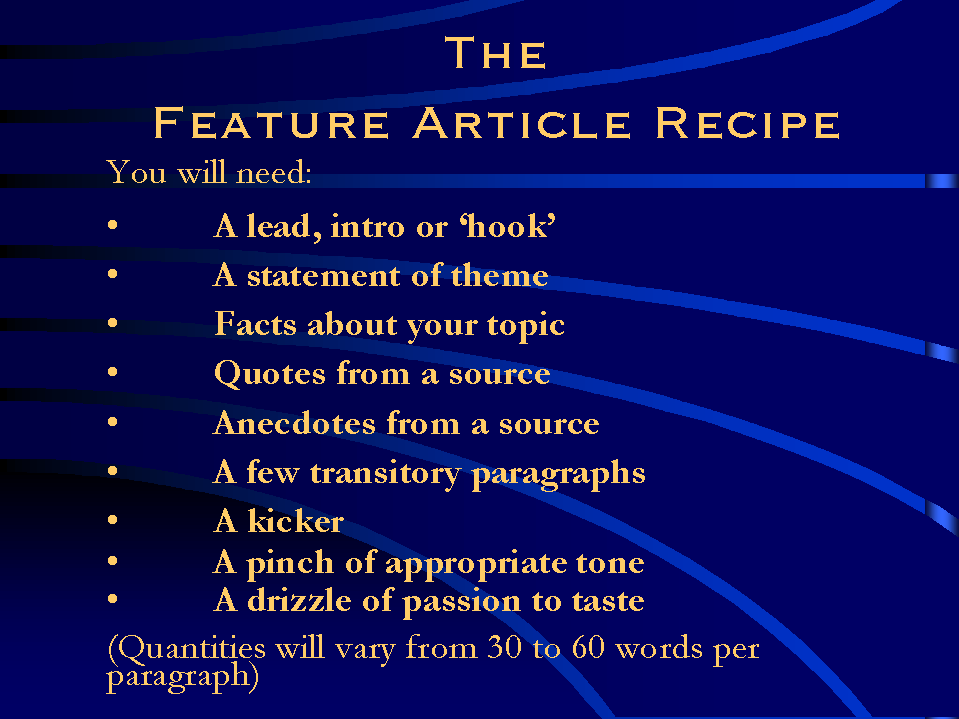
Put your ingredients together as follows...
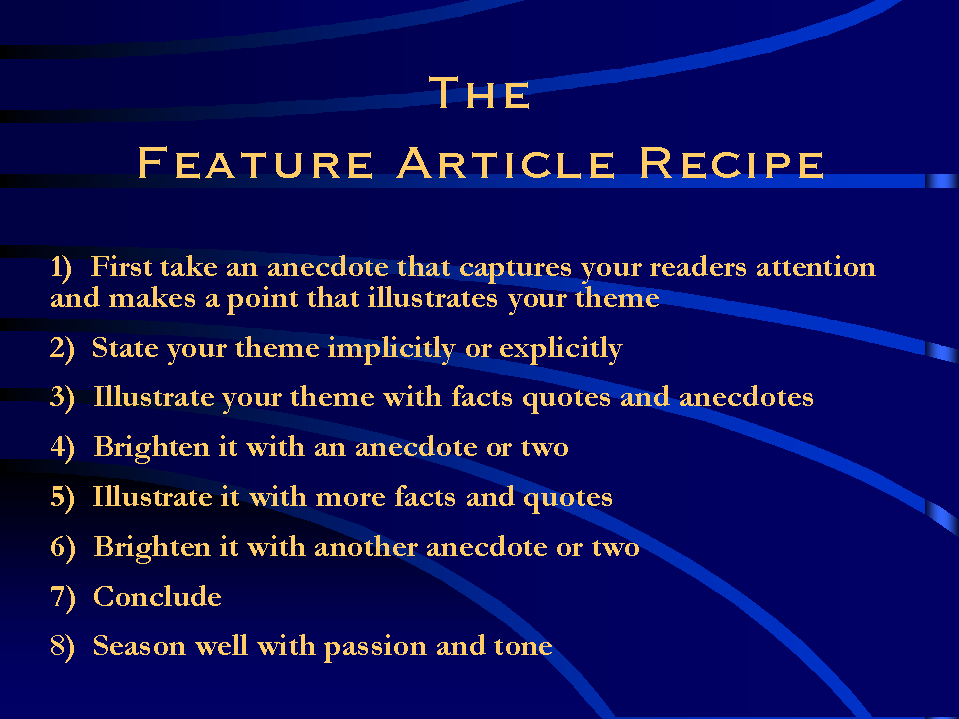
You will typically put your lead as your first paragraph, and your statement of theme (or what your article is about)
in the second paragraph. Your last papragraph will be your kicker. In between will be your facts, quotes and anecdotes all
of which will relate to your theme...
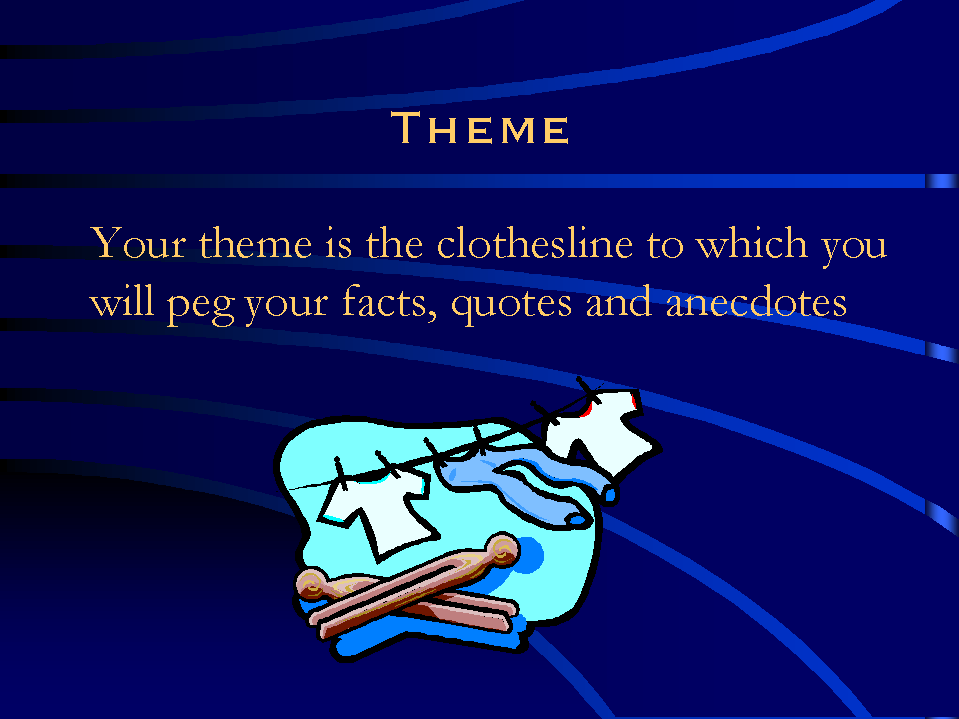
How should we define theme in the context of a feature article? It is not
simply enough to call it a topic or issue that you will write about, although this is one role your theme will play.
Your theme is the clothesline to which you will peg your facts, anecdotes and quotes. Your statement of theme will
invariably come after your lead as a means of declaring what your article is about.
You should also ensure that every quote, fact and anecdote should relate to
your theme in some way.
However, you cannot just hang your facts, anecdotes and quotes there any old
way. You will also need marshal your thoughts, mentally classify and catalogue the snippets and nuggets of information you
have gathered. Only then can you get some semblance of perspective, or the angle you will use.
Sometimes the angle will reveal itself through the gathering and reviewing
of information, but sometimes, you will need to write to a particular brief, for example if you are commissioned to write
a piece, then this will dictate the angle you adopt - or whether you get paid.
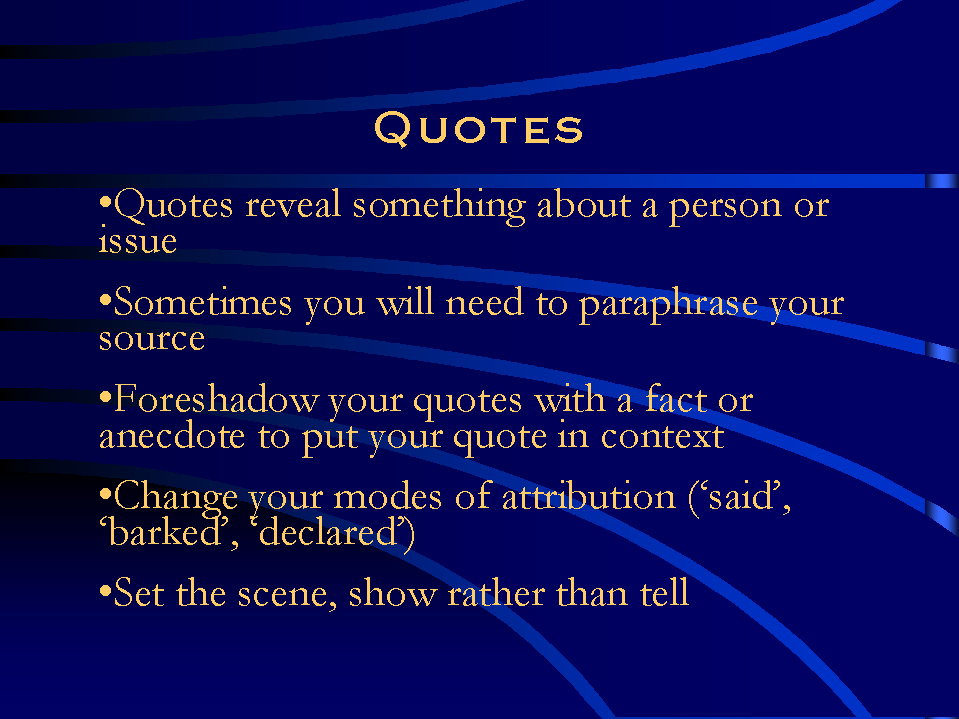
You will need to make full use of quotes for your feature article. They breath
life into a piece of writing and imbue your topic with a with a sense of immediacy.
Although you are not expected to go out and get an interview with John Howard
or Peter Beattie for your Case Study, you will be able to cull quotes from newspaper reports, and other reputable texts.
Even the hard-core interviewer will cull his or her quotes down to those that
fit the theme of your piece. You should be on the lookout for those quotes that reveal something about the person or the issue.
Sometimes you will need to paraphrase, re-stating or interpreting your source’s words because word or space restrictions
apply.
The following is a good example of this.
"Shihan points out that he’s seen a lot of politics in the martial
arts in Australia and that he doesn’t want Sakura Ryu Ju Jitsu to suffer the fate of other martial arts schools."
This example of paraphrasing was necessary because it sums up about 30 minutes
of an interview.
Often, you will need to foreshadow your quotes or set them up for the
reader.
The following illustrates how to foreshadow (Foreshadowing is
italicised).
"Shihan points out that he’s seen a lot of politics in
the martial arts in Australia and that he doesn’t want Sakura Ryu Ju Jitsu to suffer the fate of other martial arts
schools.
'This is why I’ve formed a trust, a group of trustees who I believe are true and honest and follow our
code of loyalty, honour, integrity, respect and humility. I entrust them as well as our graded black belts to look after Sakura
Ryu Ju Jitsu for the future’ he said."
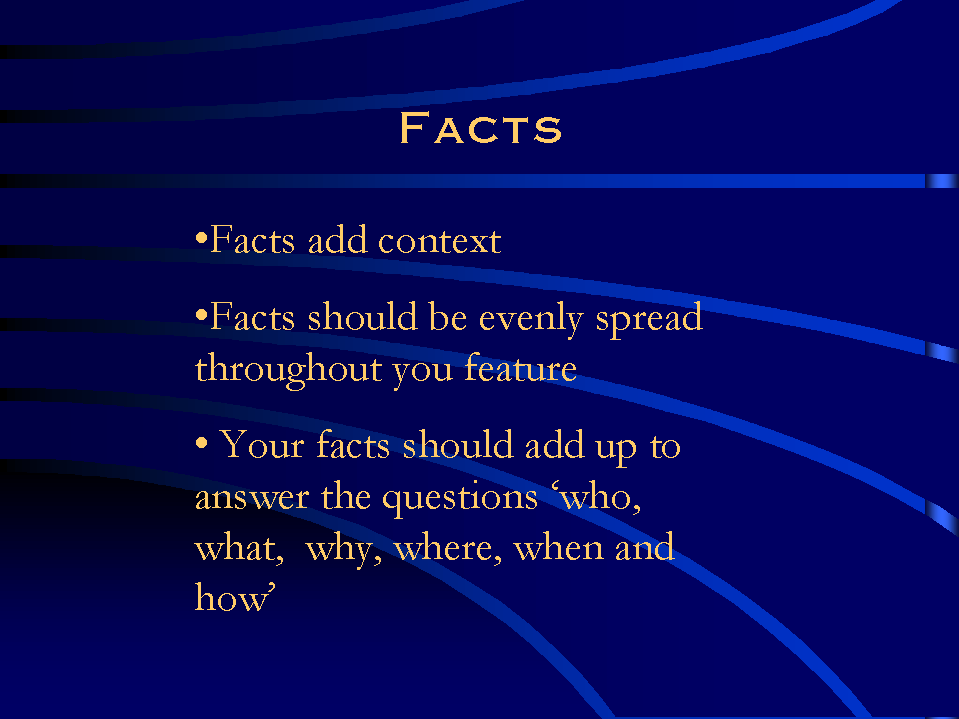
You are going to need facts for your feature that invariably means doing some
research. Facts support and enhance your writing as well as contextualising your topic.
Consider the following example:
Let’s say you are asked to write a profile on a well-known religious
and civic leader. Your background research will turn up information like the names of the school, university or seminary he
attended, the names of his wife and children; the sort of duties he performs in his job and his career achievements; that
he is a keen gardener, is fond of Mahler and watches the ABC. You’d think given these sorts of facts that you’d
have a fairly comprehensive profile of this person. Now add to this mix an accusation of a rape forty years ago and the suggestion
that this person turned a blind eye to the presence of practising paedophiles priests within his parish. These last two pieces
of information change a fairly pedestrian and fluffy profile piece into a hard news feature.
The angles you might take for a story like this can show this person
as an embattled man of the people, a victim of the adage that if you throw enough mud - some of it will stick.
You might show him as a caring family man, with quotes and anecdotes from
his wife illustrating and defending his good name.
You might also write a feature that emphasises the need for high profile figures
in public office to be beyond reproach in terms of their conduct.
This example emphasises my earlier point about how reviewing your collection
of facts, quotes and anecdotes will reveal your angle. However, your facts must be impeccable and this means that you must
often dig deeper in order to make your article compelling and more substantial than the 30 word brief from Reuters or a quick
Internet search.
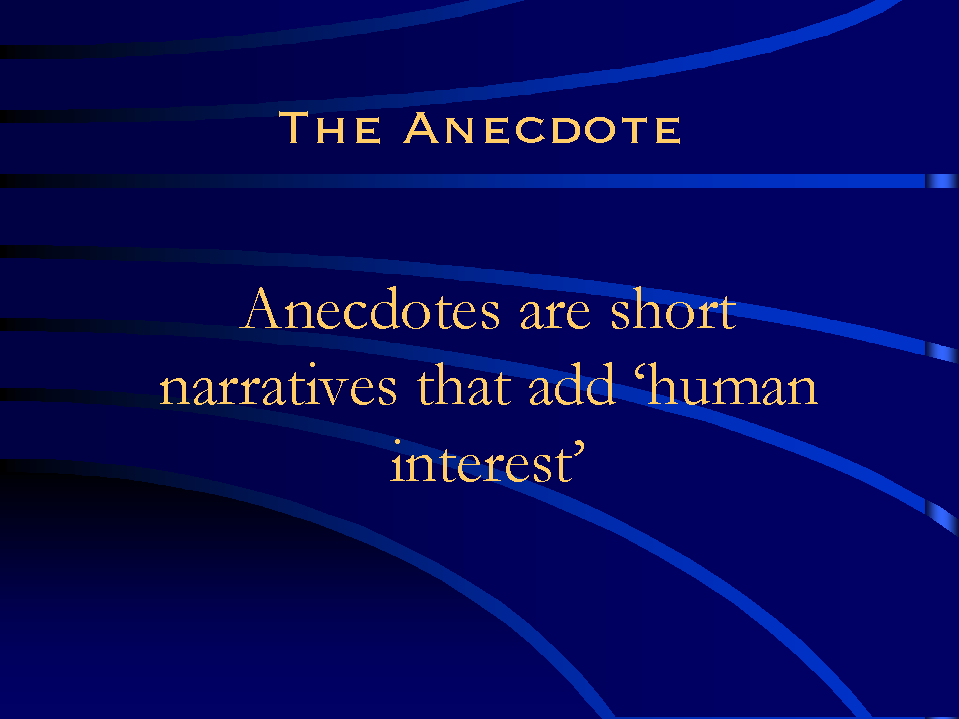
Another way of looking at the anecdote is to think of it in terms of asking the question 'what is going on here
that is interesting or entertaining?'
If you then recount this interesting point, you have an anecdote...
Now we come to the idea of a transitory papragraph, or moving from one point
to another. Consider the following example fron the Ju Jitsu article...
"Shihan’s own training continued at the Brisbane Sports School, grading to 1st Dan Black Belt (Shodan)
in 1976.
However, this association was not to last, as the School neglected to further Shihan’s training and development as
a martial artist.
‘Having spent years as a Shodan (1st Dan Black Belt), I though that this went on a bit long and when I asked my Sensei
about it, he said that if he knew I wanted to grade (to the next Dan level), he would have nominated me.
This is perhaps why Sakura Ryu Ju Jitsu has established set training periods between Gradings, with 4, 6, 8 and 10 training
months between Yellow, Orange, Green and Blue cherry blossom levels respectively, training at least twice each week.
The higher Kyu grades of Brown first and second levels, and Shodan (1st Dan Black Belt) all take 12 months of
training between each level. This includes three ‘mat’ sessions each week, and one session of what the Sakura
Ryu Ju Jitsuans’ call ‘Ultimate Sunday training’.
This training takes place on Sundays at the Sakura Ryu Ju Jitsu Honbu Dojo, which is a purpose built training complex in
Gumdale. The Dojo section of the complex was completed in January 2003, and now houses Sakura Ryu Ju Jitsu memorabilia as
well as the School’s shields and trophies. Ultimate training sessions held at the Honbu Dojo allows Shihan to coach his students to higher levels of strength and fitness, using
traditional weights and gym equipment, and the slightly unorthodox, but very effective ‘chain’.
‘Doing-the-chain’ consists of dragging a 60kg ship’s chain attached to a belt for up to four circuits
of the Honbu Dojo’s grounds, from walking pace to a brisk jog.
‘I can remember when I could barely get halfway across this paddock with this chain ’ said one Brown belt.
‘Now I can do the four [laps]. It’s hard, but I can do it’."
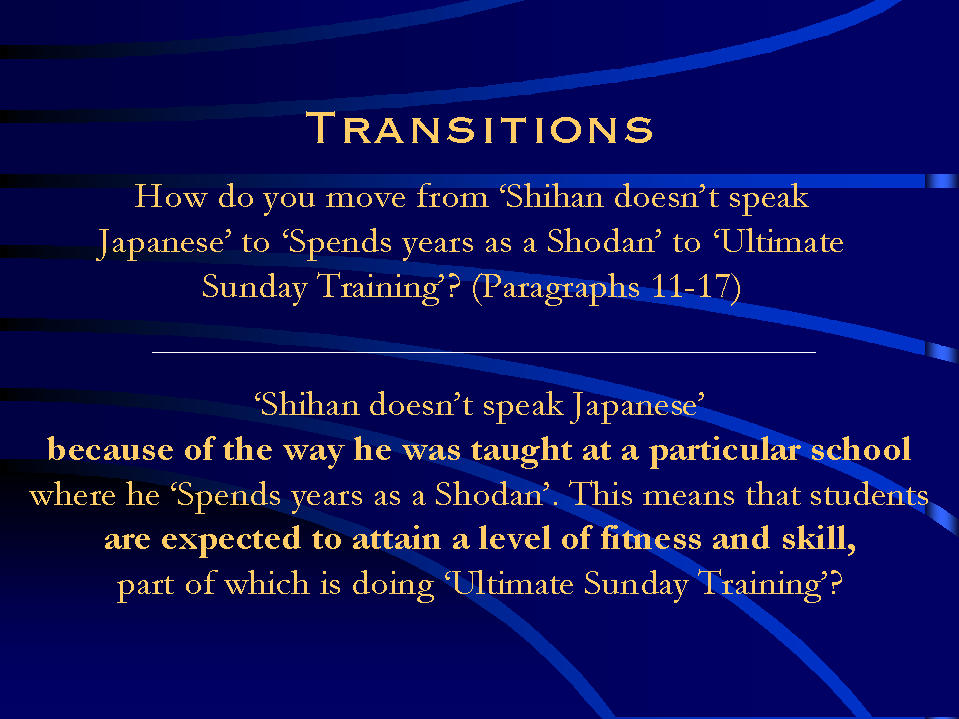
Given that there is a firmly established theme for the Ju JItsu article makes
moving around the text fairly simple.
For example, between the blocks of quotes we have these transitory paragraphs.
So, we move from three disjointed facts and quotes about Shihan not talking
in Japanese to spending years as a Shodan, to Ultimate Sunday Training to:
Shihan not talking in Japanese because of the way he was taught at a
particular school where he spent years as a Shodan. This means that he insists that students understand that
they are expected to put a certain amount of time to attain a level of fitness and skill, part of which includes Ultimate
Sunday Training. What I have just written gets the same point across as the feature article, but in a far less dynamic way
that with the use of quotes, facts and anecdotes
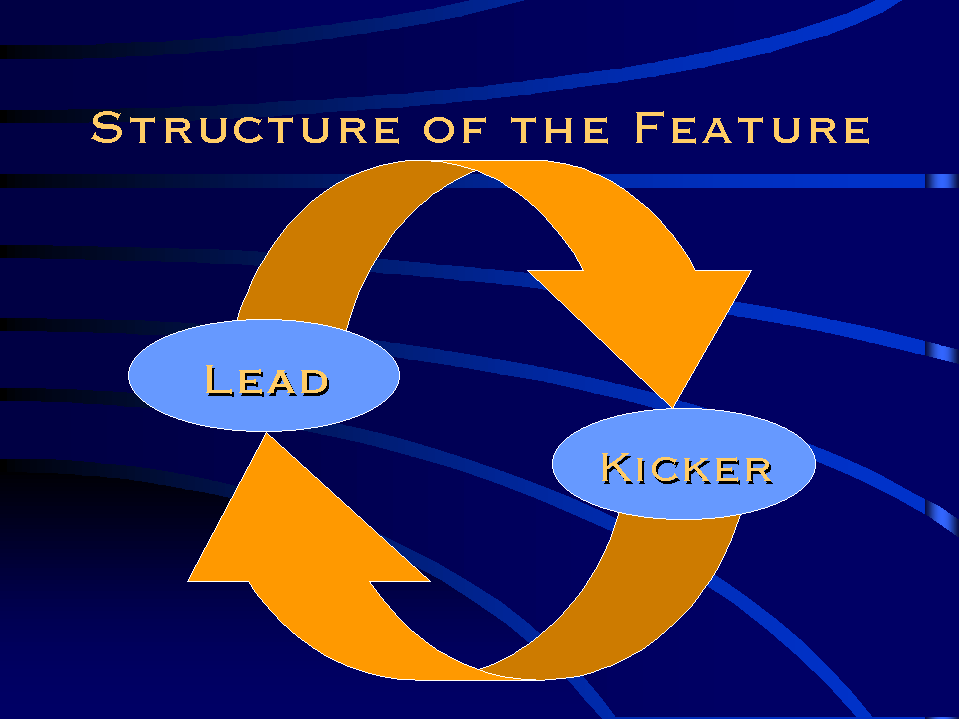
The last element of your feature article will be the kicker or the conclusion of your article. This is where the idea of
a circular structure for your article comes into play because the lead will relate to the kicker, and vice versa.
The Lead and The Kicker of the Ju Jitsu article function as a mini narrative
when put together.
"It’s a Friday night
and Shihan Reg Ellis is about to put the adult class of Sakura Ryu Ju Jitsu through its paces. Having already ‘bowed
in’, rows of Ju Jitsuans of various belt levels lay on their backs, waiting for Shihan Reg Ellis’ first instruction.
‘Heads up, knees up - Hit that mat!’ roars Shihan as the class
beats the mat with their arms in rhythmic unison. This is the start of breakfall practice where students warm up, preparing
themselves for the striking, throwing, joint locking and grappling techniques they will practice later in the session.
‘Harder! Faster!’ Shihan barks, and the class responds enthusiastically.
With an attitude like this, it’s little wonder that by the end of
the Friday night training session, the enthusiasm for Ju Jitsu and the respect shown by students towards Shihan at the beginning
of the class has not diminished under their sweat-soaked gis. As the students bow out and go off the mat, each stops
before leaving for home, thanking Shihan for their training and shaking his hand as they file out. In turn, Shihan has an
encouraging word for each of them.
‘Go harder, go faster’ he says.
Under this premise you should be able to cut and paste your lead and
kicker together to make a coherent narrative and I would recommend you try this to test how well the lead and kicker go together.
You will note with the Ju Jitsu kicker that the theme is put to bed, the opening anecdote is given an ending and that the
words ‘harder and faster' are echoed, acting as a word bridge between the two sections.
However, you must avoid ‘Fulweek disease’. This is a term coined
by The Advertiser’s staffers to describe weak and patronising kickers like ‘…and they all lived
happily ever after’.
|